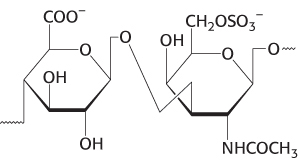
Carbohydrates are important fuel molecules, but they play many other biochemical roles, including protection against high-impact forces. The cartilage of a runner’s foot cushions the impact of each step she takes. A key component of cartilage are molecules called glycosaminoglycans, large polymers made up of many repeats of dimers such as the pair shown at the right.
[Untitled x-ray/Nick Veasey/Getty Images.]

For years, the study of carbohydrates was considered less exciting than many if not most topics of biochemistry. Carbohydrates were recognized as important fuels and structural components but were thought to be peripheral to most key activities of the cell. In essence, they were considered the underlying girders and fuel for a magnificent piece of biochemical architecture. This view has changed dramatically in the past few years. We have learned that cells of all organisms are coated in a dense and complex coat of carbohydrates. Secreted proteins are often extensively decorated with carbohydrates essential to a protein’s function. The extracellular matrix in higher eukaryotes—the environment in which the cells live—is rich in secreted carbohydrates central to cell survival and cell-to-cell communication. Carbohydrates, carbohydrate-containing proteins, and specific carbohydrate-binding proteins are required for interactions that allow cells to form tissues, are the basis of human blood groups, and are used by a variety of pathogens to gain access to their hosts. Indeed, rather than being mere infrastructure components, carbohydrates supply details and enhancements to the biochemical architecture of the cell, helping to define the functionality and uniqueness of the cell.
A key property of carbohydrates that allows their many functions is the tremendous structural diversity possible within this class of molecules. Carbohydrates are built from monosaccharides, which are small molecules—typically containing from three to nine carbon atoms that are bound to hydroxyl groups—that vary in size and in the stereochemical configuration at one or more carbon centers. These monosaccharides can be linked together to form a large variety of oligosaccharide structures. The sheer number of possible oligosaccharides makes this class of molecules information rich. This information, when attached to proteins, can augment the already immense diversity of proteins.
The realization of the importance of carbohydrates to so many aspects of biochemistry has spawned a field of study called glycobiology. Glycobiology is the study of the synthesis and structure of carbohydrates and how carbohydrates are attached to and recognized by other molecules such as proteins. Along with a new field comes a new “omics” to join genomics and proteomics—glycomics. Glycomics is the study of the glycome, all of the carbohydrates and carbohydrate-associated molecules that cells produce. Like the proteome, the glycome is dynamic, depending on cellular and environmental conditions. Unraveling oligosaccharide structures and elucidating the effects of their attachment to other molecules constitutes a tremendous challenge in the field of biochemistry.

